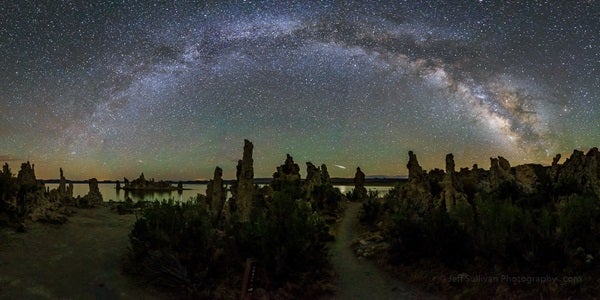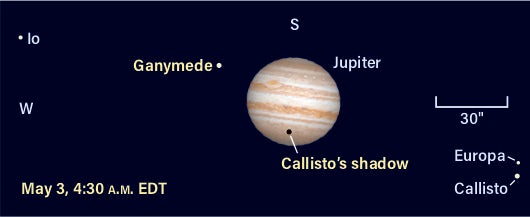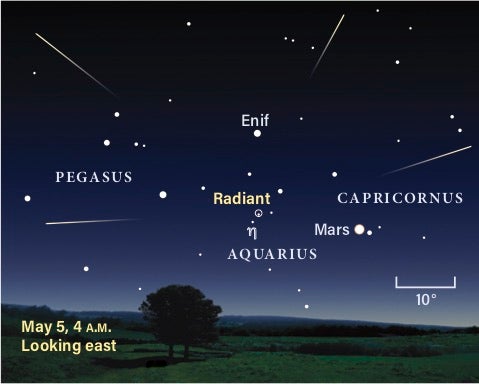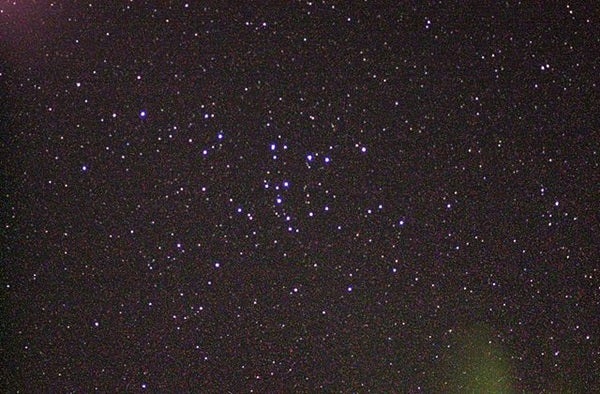Winter’s constellations are quickly disappearing from our sky, so now is the time to glimpse your favorites before they’re gone. The first week of May is one of the last times you’ll be able to easily observe the night sky’s brightest star, Sirius. An hour after sunset, this magnitude –1.5 star is already less than 12° high in the southwest. Its low altitude offers a unique view: As it sinks toward the horizon, you’ll notice Sirius furiously twinkling, or scintillating. Look through binoculars or a telescope, and it may appear as a madly dancing point of light, cycling through the colors of the rainbow almost as if you’re looking through a kaleidoscope. This show is simply an effect of observing the star through the thick layers of turbulent air low on the horizon, which blur the image like looking at a sparkling coin through water.
Saturday, May 2
Magnitude –2.3 Jupiter rises just before 2 A.M. for observers at mid-northern latitudes. Saturn, glowing at magnitude 0.6, rises about 20 minutes later and is less than 5° from Jupiter. Watch for the pair in the southeastern sky, not far from the Milky Way (if you’re looking from a dark location). As the planets begin to march upward, you’ll see Altair, one of the three stars that make up the famous Summer Triangle asterism, about 20° above the horizon. The magnitude 0.8 luminary lies due north of the planets.
Northeast of Altair is the second point in the Triangle, magnitude 1.3 Deneb. Skim your eyes west of Deneb to reach the third point: magnitude 0 Vega. As spring gives way to summer, the Summer Triangle will rise earlier and climb higher in the sky until it is directly overhead at night during the height of the Northern Hemisphere’s hottest season.
If you own even a small telescope, you’ll want to pull it out to watch a double feature around Jupiter this morning. As Jupiter rises, Callisto’s large shadow is already visible against the gas giant’s northern cloud tops. Callisto itself is located east of the planet, while Ganymede is to the west. At 4:49 A.M. CDT, the bright spot of Ganymede begins to disappear behind the planet’s limb — an event that takes just seven minutes. At the same time, Callisto’s shadow slips off the disk, which takes nearly three times as long because Callisto’s orbit is wider and causes it to move slower than Ganymede. Twilight is quickly washing out the East Coast sky during this pair of events, but intrepid observers should still be able to catch the show, albeit against a brighter backdrop.
Monday, May 4
If you’re a fan of the Star Wars franchise, May 4 — as in, May the fourth be with you — is possibly one of your favorite days. In celebration of the date, step outside early this morning to find the constellation Cygnus the Swan high above the eastern horizon. The swan’s tail is marked by the bright star Deneb and its head by Albireo 22° to the southwest. Three bright stars march in a line between them, comprising the body of the swan. Find the star closest to Deneb — that’s magnitude 2 Sadir. Stretching 17° to that star’s northwest is one of the swan’s wings, the tip of which is marked by Kappa [κ] Cygni, just a touch brighter than magnitude 4.
Although you can’t see it because its components are too faint, just 1.5° south of Kappa is the Kepler-16 system. This binary star system is home to one known planet — Kepler-16b, the first planet confirmed to have two suns, like Luke Skywalker’s home of Tatooine. However, Kepler-16b is a gas giant one-third the mass of Jupiter, not a terrestrial planet that might serve as home to Jawas, Tusken Raiders, or Banthas.
Later today, Mercury passes through superior conjunction at 6 P.M. EDT. The smallest planet is now on its way to meet up with Venus for a conjunction later in the month.
The Eta Aquariid meteor shower, which has been active since late April, peaks this morning. Although this shower tends to put on a strong show in the Southern Hemisphere, its low radiant in the Northern Hemisphere results in a predicted rate of 10 meteors per hour at its peak. But with good weather and a bit of luck, you may still catch some of the shower’s meteors this morning.
Mars hangs near the Eta Aquariids’ radiant, low in the sky around 4 A.M. local time. Although it’s typically best to concentrate on an area opposite the radiant in the sky, a bright waxing Moon is setting in the west, nixing that plan of attack. Instead, scan the other three quadrants of the sky to catch errant shooting stars. These are the debris left behind by the famous Comet 1/P Halley, which last graced our skies in 1986 and will return in the early 2060s.
Tonight, the Moon will reach perigee — the closest point in its orbit to Earth — at 11:03 P.M. EDT. It will then sit 223,478 miles (359,653 kilometers) from our planet.
Wednesday, May 6
Not to be shown up by its fellow Galilean satellites, Jupiter’s moon Io and its shadow cross the face of the gas giant this morning. The whole thing starts at 2:59 A.M. EDT, as Io’s shadow slips into view on Jupiter’s eastern limb. At 4:13 A.M. EDT, Io begins to cross in front of the same limb, with its shadow more than halfway across the planet’s face. An hour later, the moon’s shadow disappears, with the moon slipping off the planet’s disk beginning at 5:29 A.M. CDT. (East Coast observers will miss this finale as the Sun rises and interrupts the show.)
Thursday, May 7
Full Moon occurs at 6:45 A.M. EDT. Rising as the Sun sets tonight, our satellite’s bright light will wash out much of the dark sky. But that doesn’t mean there aren’t still tempting targets to observe. The Beehive Cluster (M44) is a large open cluster in the constellation Cancer the Crab. Also known as Praesepe, this cluster is one of the closest to Earth at around 600 light-years away. The entire cluster covers an area nearly three Full Moons in size and contains 1,000 or so stars. On a dark night, it’s visible to the naked eye; even on this bright, moonlit night, you’ll be able to catch several of the cluster’s young stars in binoculars or a telescope. More will pop out as you move to larger apertures.
The bright Moon continues to wash out fainter objects, but pull out your binoculars or telescope to try for another star cluster tonight: the Coma star cluster. It’s easy to starhop to this grouping, which is located due east of Leo the Lion’s brightest star, Regulus. Draw a line from Regulus east to magnitude 2.6 Zosma in the lion’s hindquarters, then continue along that line for about the same distance to reach the cluster. If you have access to a dark-sky viewing site, remember how to find this scattering of stars — under country (and moonless) skies, it’s visible to the unaided eye.

Our exclusive Sky Guide 2020 is now available! This free downloadable pamphlet contains a month-by-month rundown of 2020’s biggest celestial events, from Mars’ best opposition in years to the return of totality in South America this December. Check out Astronomy’s Sky Guide 2020 now!













